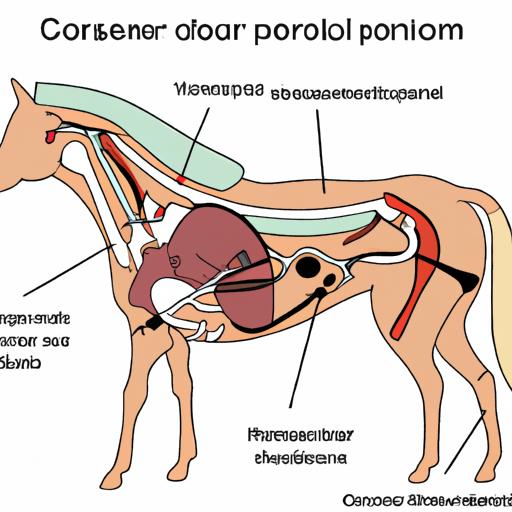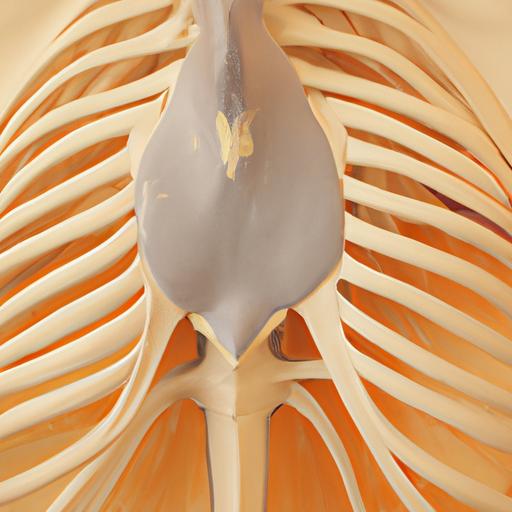Unlock the secrets of the coracoid process of scapula in horses. Discover its importance, care, and impact on equine performance.
Introduction

Welcome to Horsemasterypro.com, where we delve into the intricate world of equine anatomy to unlock the secrets behind optimal horse health and performance. Today, we embark on an exciting journey as we explore the enigmatic coracoid process of the scapula in horses. Have you ever wondered about the hidden wonders within a horse’s body? Well, the coracoid process is one such marvel that holds immense significance for our equine companions.
A. Definition of the coracoid process of scapula in horses
Picture this: nestled within the scapula, there lies a small, hook-like structure known as the coracoid process. It serves as an essential attachment point for muscles, tendons, and ligaments, allowing for fluid movement and stability in your horse’s shoulder joint. This unique anatomical feature showcases the intricacies of equine physiology and the marvels of nature’s design.
B. Importance and role of the coracoid process in horse anatomy
Now, you may be wondering, what role does the coracoid process play in the grand symphony of horse anatomy? Well, my friend, it serves as a vital link between the forelimb and the rest of the horse’s body. Acting as a lever arm, the coracoid process facilitates the transmission of forces generated during locomotion, ensuring efficient movement and weight-bearing. Without this crucial structure, your horse’s shoulder joint would lack the stability and strength needed for optimal performance.
C. Significance of understanding the coracoid process for horse health and performance
As responsible horse owners and enthusiasts, delving into the depths of equine anatomy grants us valuable insights into ensuring our horses’ well-being and enhancing their performance. By comprehending the intricacies of the coracoid process, we empower ourselves to make informed decisions regarding exercise routines, training techniques, and rehabilitation strategies. Knowledge truly is power when it comes to safeguarding our equine partners’ health and unlocking their full athletic potential.
In the upcoming sections, we will dive deeper into the anatomy, development, common disorders, and optimal care of the coracoid process. Prepare to unravel the mysteries that lie beneath the surface, as we embark on an enlightening journey toward horsemastery.
Remember, at Horsemasterypro.com, we strive to provide you with expert knowledge, trustworthy insights, and a passion for all things equine. Stay tuned for the next section, where we explore the fascinating anatomy of the coracoid process in horses.
Anatomy of the Coracoid Process in Horses
A. Description of the coracoid process and its location in the scapula
Let’s dive into the captivating world of equine anatomy and explore the coracoid process in greater detail. The coracoid process is a bony projection that extends from the scapula, commonly known as the shoulder blade. Located on the cranial aspect of the scapula, this distinctive structure curves forward and downward, resembling a hook-like formation. Its unique shape and position make it easily distinguishable within the intricate framework of the horse’s shoulder joint.
B. Comparison of the coracoid process in horses to other animals
As we uncover the wonders of the coracoid process, it’s fascinating to note that horses aren’t the only creatures to possess this remarkable anatomical feature. In fact, other species, such as birds and reptiles, also exhibit a coracoid process. However, the coracoid process in horses differs in size and shape, showcasing the intricacies of evolution and adaptation to specific locomotor requirements.
C. Functions and biomechanics associated with the coracoid process in horses
Now, let’s unravel the functional significance of the coracoid process in equine biomechanics. This structure plays a crucial role in stabilizing the shoulder joint during weight-bearing and locomotion. Acting as a strong attachment point for muscles, tendons, and ligaments, the coracoid process allows for efficient transmission of forces generated during movement. It acts as a lever arm, facilitating the coordinated motion of the forelimb, and contributes to the overall stability and balance of the horse.
Furthermore, the coracoid process serves as an anchor for important muscles involved in shoulder flexion and extension, allowing for powerful, coordinated movements. Without the proper functioning of the coracoid process, your horse’s shoulder joint would lack the necessary stability and range of motion required for optimal performance in various disciplines.
In the next section, we will delve into the intriguing aspects of the development and growth of the coracoid process in horses. Join me as we uncover the secrets behind the formation of this remarkable anatomical structure and its implications for equine health and performance.
Development and Growth of the Coracoid Process in Horses
Understanding the development and growth of the coracoid process in horses unveils yet another layer of the fascinating world of equine anatomy. Let’s dive into the intricate journey this structure undergoes from embryonic development to the various stages of a horse’s life.
A. Embryonic development of the coracoid process
During the early stages of embryonic development, the coracoid process begins as a cartilaginous structure. As the fetus matures, this cartilage gradually ossifies, transforming into a solid bone structure. This transformation is a testament to the miraculous process of growth and development within the womb, shaping the coracoid process into its final form.
B. Factors influencing the growth and maturation of the coracoid process in horses
Several factors play a crucial role in influencing the growth and maturation of the coracoid process in horses. Genetic factors, nutrition, and exercise all contribute to the development of this structure. Adequate nutrition, including a balanced diet rich in essential minerals and vitamins, ensures proper bone formation. Furthermore, regular exercise and controlled physical activity promote the healthy development of the coracoid process, strengthening it to withstand the demands of a horse’s active lifestyle.
C. Changes in the coracoid process during different stages of a horse’s life
Just as a horse grows and matures, the coracoid process undergoes changes during different stages of its life. In young foals, the coracoid process may still be developing and gradually ossifying. As the horse progresses into adulthood, the coracoid process reaches its full development and stability. However, it is essential to note that the coracoid process continues to adapt and remodel throughout a horse’s life, responding to changes in exercise intensity and workload.
As we unravel the mysteries of the coracoid process, we gain valuable insights into the developmental milestones and changes that occur throughout a horse’s life. By understanding these intricacies, we can optimize our horse’s growth and well-being, ensuring they reach their full athletic potential.
Stay tuned for the next section, where we delve into common disorders and injuries associated with the coracoid process in horses. Together, we will navigate the path to horsemastery and equip ourselves with the knowledge to keep our equine companions in optimal health.
Common Disorders or Injuries Associated with the Coracoid Process in Horses
As we continue our exploration of the coracoid process, it is essential to shine a light on the potential disorders and injuries that can affect this crucial anatomical feature. Just like any other part of the horse’s body, the coracoid process is susceptible to various conditions that can hinder your horse’s performance and well-being. Let’s dive into the common disorders and injuries associated with this remarkable structure.
A. Overview of common disorders or injuries affecting the coracoid process
The coracoid process, although small, is not exempt from the challenges that horses may face. Common disorders and injuries that can afflict this vital structure include coracoid process fractures, muscle strains, and ligamentous injuries. These conditions can arise from various factors, such as trauma, overexertion, or repetitive stress. Recognizing the signs and symptoms of these disorders is crucial for prompt intervention and effective management.
B. Symptoms, diagnosis, and treatment options for coracoid process disorders in horses
When it comes to identifying coracoid process disorders, attentive horse owners can be the first line of defense. Keep a keen eye out for signs such as lameness, swelling, heat, and sensitivity in the shoulder region. If you suspect a coracoid process disorder, it is vital to consult a veterinarian for a comprehensive diagnosis. Diagnostic techniques may include physical examinations, imaging studies, and potentially, a biopsy. Once a diagnosis is established, treatment options can range from conservative management, such as rest and physical therapy, to surgical intervention for more severe cases.
C. Rehabilitation and prevention strategies for coracoid process injuries in horses
Rehabilitation plays a crucial role in the recovery of horses with coracoid process injuries. Working closely with your veterinarian and equine rehabilitation specialist, a tailored program can be developed to promote healing, rebuild strength, and restore range of motion. This may involve a combination of therapeutic exercises, targeted physiotherapy, and controlled exercise regimens. Additionally, implementing preventive measures is paramount in safeguarding your horse’s coracoid process. Proper conditioning, gradual training progression, and regular veterinary check-ups can aid in preventing injuries and maintaining optimal equine shoulder health.
By understanding the common disorders, their symptoms, and the available treatment options, we equip ourselves with the knowledge to support our horses through any challenges they may face. In the next section, we will explore the importance of proper care and management of the coracoid process in horses, ensuring our equine partners can thrive in their pursuits.
Conclusion
In conclusion, the coracoid process of the scapula in horses is a fascinating and vital component of their anatomy. By understanding its definition, importance, and role in horse health and performance, we can take significant strides towards ensuring the well-being and optimal function of our equine companions.
As we have learned, the coracoid process serves as a crucial attachment point for muscles, tendons, and ligaments, enabling fluid movement and stability in the shoulder joint. It plays a pivotal role in transmitting forces during locomotion, contributing to efficient movement and weight-bearing.
To maintain the health and function of the coracoid process, it is essential to consider the impact of exercise and workload on this structure. Proper conditioning techniques, such as gradual training progression and appropriate warm-up and cool-down routines, can help prevent overuse injuries and promote the longevity of the coracoid process.
Regular veterinary check-ups and examinations are also paramount in monitoring the coracoid process’s condition. These evaluations allow for early detection of any abnormalities or injuries, enabling prompt intervention and treatment.
At Horsemasterypro.com, we emphasize the importance of holistic horse care and management. By nurturing a deep understanding of the coracoid process and its significance, we can optimize our horses’ performance, prevent injuries, and enhance their overall well-being.
Thank you for joining us on this enlightening exploration of the coracoid process of the scapula in horses. We hope this article has provided valuable insights and empowered you on your journey towards horsemastery. For more expert advice and trustworthy information, visit horsemasterypro.com.
Remember, the key to unlocking your horse’s full potential lies in understanding every facet of their remarkable anatomy. Together, let’s strive for excellence in equine care and nurture the extraordinary bond we share with our equine companions.


